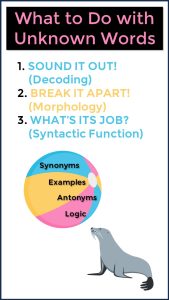Free Structural Analysis, Syllabication & Oral Language Resources

FREE Phonics Assessments
Word study is crucial to effective reading and spelling instruction. Knowing the structural components of words, including roots, affixes, and grammatical inflections will help your students read with greater understanding and less fear of multi-syllabic words. Studying how words are put together will help your students properly pronounce words. Learning the parts of words will help your student improve their vocabulary. Practicing the rules and patterns of word formation will help your students become better spellers. Oh yes… using the skills of word analysis will also help your students perform better on standardized English-language arts and reading tests.
Following are articles, free resources, and teaching tips regarding structural analysis, syllabication, and oral language development from the Pennington Publishing Blog. Also, check out the quality instructional programs and resources offered by Pennington Publishing.
Structural Analysis, Syllabication, and Oral Language
Ten English Accent Rules
https://blog.penningtonpublishing.com/reading/ten-english-accent-rules/
The Ten English Accent Rules are important to understand and apply to be able to correctly pronounce and spell English words.
How to Teach English Accent Rules
https://blog.penningtonpublishing.com/reading/how-to-teach-english-accent-rules/
Teaching students the syllable and accent rules through effective practice will noticeably improve their word attack and spelling skills. The accent rules and teaching procedure work well for both primary English speakers and English language-learners at all grade levels.
How to Teach Syllabication: The Syllable Rules
https://blog.penningtonpublishing.com/reading/how-to-teach-syllabication-the-syllable-rules/
How to Teach Syllabication: The Syllable Rules is a three-minute whole-class instructional strategy that teaches students to properly pronounce and spell all of the phonetic sound-spelling and syllable patterns.
Twenty Advanced Syllable Rules
https://blog.penningtonpublishing.com/reading/twenty-advanced-syllable-rules/
The Twenty Advanced Syllable Rules are critical to accurate pronunciation, decoding, and spelling. Knowing the patterns of affixes and roots will also facilitate vocabulary acquisition.
20 Embarrassing Mispronunciations
https://blog.penningtonpublishing.com/reading/20-embarrassing-mispronunciations/
Educated Americans often look down their long noses at those who mispronounce common words. However, even these literary illuminati have their fair share of embarrassing pronunciation gaffes.
Top 40 Pronunciation Pet Peeves
https://blog.penningtonpublishing.com/reading/top-40-pronunciation-pet-peeves/
Here is the definitive list of the Top 40 Pronunciation Pet Peeves that drive Americans crazy. Read, laugh, and cringe over mistakes that you or your friends make when saying these words.
More Articles, Free Resources, and Teaching Tips from the Pennington Publishing Blog
 English-Language Arts and Reading Intervention Articles and Resources
English-Language Arts and Reading Intervention Articles and Resources
Bookmark and check back often for new articles and free ELA/reading resources from Pennington Publishing.
- Free Teaching Reading Resources
- Grammar and Mechanics
- Vocabulary
- English-language Arts Standards
- English-language Arts Instruction
- Essay Resources and Lessons
- The Writing Process/Writers Workshop
- Writing Style
- Spelling
- Structural Analysis/Syllabication/Oral Language
- ELA/Reading Assessments
- Independent Reading
- Reading Intervention (RtI Resources)
- EL/ESL/ELD
- Assessment-based Individualized Instruction/Differentiated Instruction
- Critical Thinking
- Study Skills
- Test Preparation
- Developmental Characteristics
- Professional Development
- Literacy Centers
- Close Reading
- Reading Comprehension
………………………………………………………………………………………………………………………………………………………………………………………………………………………………………………………………………………………
The Science of Reading Intervention Program
The Science of Reading Intervention Program: Word Recognition includes explicit, scripted instruction and practice with the 5 Daily Google Slide Activities every reading intervention student needs: 1. Phonemic Awareness and Morphology 2. Blending, Segmenting, and Spelling 3. Sounds and Spellings (including handwriting) 4. Heart Words Practice 5. Sam and Friends Phonics Books (decodables). Plus, digital and printable sound wall cards and speech articulation songs. Print versions are available for all activities. First Half of the Year Program (55 minutes-per-day, 18 weeks)
The Science of Reading Intervention Program: Language Comprehension resources are designed for students who have completed the word recognition program or have demonstrated basic mastery of the alphabetic code and can read with some degree of fluency. The program features the 5 Weekly Language Comprehension Activities: 1. Background Knowledge Mentor Texts 2. Academic Language, Greek and Latin Morphology, Figures of Speech, Connotations, Multiple Meaning Words 3. Syntax in Reading 4. Reading Comprehension Strategies 5. Literacy Knowledge (Narrative and Expository). Second Half of the Year Program (30 minutes-per-day, 18 weeks)
The Science of Reading Intervention Program: Assessment-based Instruction provides diagnostically-based “second chance” instructional resources. The program includes 13 comprehensive assessments and matching instructional resources to fill in the yet-to-be-mastered gaps in phonemic awareness, alphabetic awareness, phonics, fluency (with YouTube modeled readings), Heart Words and Phonics Games, spelling patterns, grammar, usage, and mechanics, syllabication and morphology, executive function shills. Second Half of the Year Program (25 minutes-per-day, 18 weeks)
The Science of Reading Intervention Program BUNDLE includes all 3 program components for the comprehensive, state-of-the-art (and science) grades 4-adult full-year program. Scripted, easy-to-teach, no prep, no need for time-consuming (albeit valuable) LETRS training or O-G certification… Learn as you teach and get results NOW for your students. Print to speech with plenty of speech to print instructional components.
SCIENCE OF READING INTERVENTION PROGRAM RESOURCES HERE for detailed product description and sample lessons.




